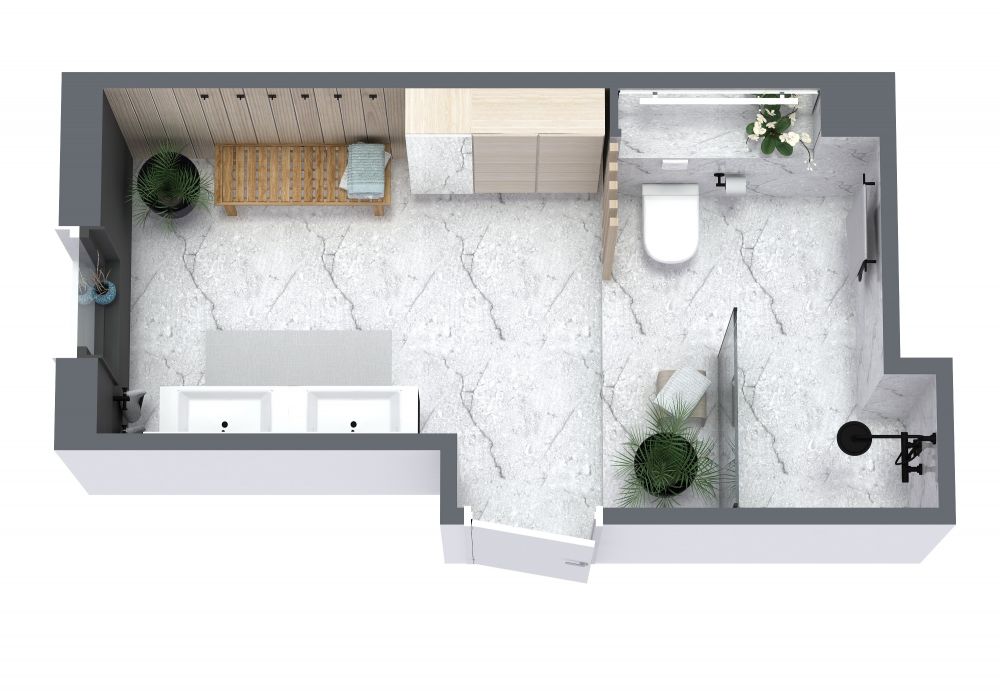Bathroom Floor Plan Examples
The design of your bathroom is something that should be carefully planned. After all, a functional and beautiful bathroom can make a big difference in how you start and end your day. By determining your goals and developing a great bathroom floor plan, you can create a room that works well for your needs and avoid common layout mistakes.
Read More
Your bathroom goals
Before you start browsing floor plans and designing your dream bathroom, it’s important to determine your goals for the space. One of the first questions to think about is who will use the bathroom. A couple may have very different needs than a teen, child, or occasional guest. Along with who, think through how and when they will use the room. For example, will two people get ready at the same time each morning? If so, perhaps dual sinks are ideal. Is the bathroom for children, one who prefers baths and another who showers? Thus, would a combination tub and shower be a good solution? Is this bathroom for elderly in-laws, and would aging-in-place features, such as grab bars, be helpful?
It’s also a good idea to jot down what you like and dislike in the current bathrooms you use. Plus, one common mistake in bathroom design is to forget storage - for toiletries, makeup, grooming supplies, cleaning products, and bath linens. So make sure you plan ahead for this important need. Also, consider privacy - for example, is a separate room for the toilet preferred?
Common bathroom types
There are 4 main components for a bathroom - sink, toilet, bathtub, and shower and the bathroom type identifies which of them are planned for a particular bathroom. Here are the main bathroom types:
- Full Bathroom - contains all 4 main bathroom components: a sink, toilet, bathtub, and shower.
- ¾ Bathroom - contains 3 of the 4 components. This usually means a sink and toilet, plus either a standing shower or a bathtub.
- ½ Bathroom or Powder Room - contains 2 of the 4 components, usually a toilet and a sink. Powder rooms are often located off a hallway near the kitchen and main living area for easy access by residents and guests.
- Primary or Master Bathroom - The primary bathroom is usually the nicest in the house and contains all 4 main bathroom components: a sink, toilet, bathtub, and shower. Since a primary bath is designed for 2 people, it often contains a double vanity sink, a separate shower and bathtub, and sometimes a semi-enclosed toilet for privacy.
Other bathroom types include; Jack & Jill bathroom, which is a full or ¾ bathroom located between two bedrooms and accessed from each side - thus, it has two entrance doors. Accessible bathroom: designed for accessibility, usually following ADA (Americans with Disabilities Act) guidelines. Bathroom with washer/dryer: Some countries have an option for a washer/dryer in a bathroom.
Common bathroom shapes and sizes
Bathroom layouts come in many shapes and sizes, but the overall footprint often falls into a few general categories. If you are remodeling an existing space, you may already have a footprint in mind for your new bathroom layout. That being said, you do not have to stick to a standard layout - depending on your space and budget, there are endless ways to design a custom bathroom. Here are some of the most popular shapes:
- Rectangular Bathroom - Rectangle shape bathrooms start at about 3’ x 5’ (about .9 m x 1.5 m) for a powder room and 5’ x 8’ (about 1.5 m x 2.4 m) for a ¾ or full bathroom, and get larger from there.
- Square Bathroom - Square-shaped bathrooms start at about 4.5’ x 4.5’ (about 1.4m x 1.4 m) for a powder room and about 5.5’ x 5.5’ (1.7 m x 1.7 m) for a ¾ bathroom containing a corner shower.
- Narrow Bathroom - Narrow-shaped bathrooms start at about 3’ x 6’ (about .9 m x 1.8 m) for a powder room and 3’ x 9’ (about .9 m x 2.7m) for a ¾ bath with a standalone shower.
- Other Bathroom Shapes - Other fairly typical bathroom footprints include L shape, bump out, or alcove.
Code Requirements
Bathroom codes and guidelines vary from country to country and even from one locale to another. So it’s essential to check with your local permitting agency before creating your final bathroom floor plan. Here are a few examples of code requirements that affect a bathroom layout:
- Sinks - Allow for 21” (53 cm) clearance in front of the sink for someone to stand.
- Toilet - As with sinks, allow 21” ( 53 cm) in front of the toilet at a minimum. Many designers recommend 30” if possible. Additionally, allow at least 15” (38 cm) from the toilet centerline to the nearest other fixture or wall.
- Shower - In many locations, the minimum size of a shower is 30” x 30” inches (76 x 76 cm). Shower doors should either slide or if they open outward, allow a minimum clearance of 24” (60 cm) for the door swing.
- Electrical - Switches should be 60” (1,5 m) from a tub or shower.
- Ventilation - Window or fan. Wet bathrooms need ventilation. Many areas require either a window that can open or a ceiling fan.
- Ceiling Height - The minimum ceiling height is 7 ft (2.13 m).
Are you ready to design a dream bathroom? Define your goals, try out different layouts, and review your best options with professionals to make sure your final bathroom floor plan is up to code!